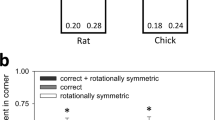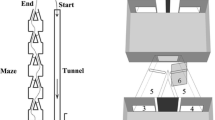Abstract
Vertebrate species use geometric information and non-geometric or featural cues to orient. Under some circumstances, when both geometric and non-geometric information are available, the geometric information overwhelms non-geometric cues (geometric primacy). In other cases, we observe the inverse tendency or the successful integration of both cues. In past years, modular explanations have been proposed for the geometric primacy: geometric and non-geometric information are processed separately, with the geometry module playing a dominant role. The modularity issue is related to the recent debate on the encoding of geometric information: is it innate or does it depend on environmental experience? In order to get insight into the mechanisms that cause the wide variety of behaviors observed in nature, we used Artificial Life experiments. We demonstrated that agents trained mainly with a single class of information oriented efficiently when they were exposed to one class of information (geometric or non-geometric). When they were tested in environments that contained both classes of information, they displayed a primacy for the information that they had experienced more during their training phase. Encoding and processing geometric and non-geometric information was run in a single cognitive neuro-representation. These findings represent a theoretical proof that the exposure frequency to different spatial information during a learning/adaptive history could produce agents with no modular neuro-cognitive systems that are able to process different types of spatial information and display various orientation behaviors (geometric primacy, non-geometric primacy, no primacy at all).













Similar content being viewed by others
Notes
The activation function is defined by: \( \phi (x) = \frac{1}{{1 + {\text{e}}^{ - kx} }} \) where x is the weighted sum of inputs to the unit.
References
Belew RK, Mitchell M (eds) (1996) Adaptive individuals in evolving populations: models and algorithms. Addison Wesley, Reading
Benhamou S, Poucet B (1998) Landmark use by navigating rats (Rattus Norvegicus): contrasting geometric and featural information. J Comp Psychol 112:317–322
Berthouze L, Ziemke T (eds) (2003) Epigenetic robotics: modelling cognitive development in robotic systems. Special issue of Connection Science, 15(4)
Bingman VP, Bagnoli P, Ioalè P, Casini G (1989) Behavioural and anatomical studies of the avian hippocampus. In: Chan-Palay V, Koehler C (eds) The hippocampus, new vistas, neurology and neurobiology, vol 52. Alan R. Liss, New York, pp 379–394
Braithwaite VA, Armstrong JD, McAdam HM, Huntingford FA (1996) Can juvenile salmon use multiple cue systems in spatial learning? Anim Behav 51:1409–1415
Brown AA, Spetch ML, Hurd PL (2007) Growing in circles: rearing environment alter spatial navigation in fish. Psycholog Sci 18:569–573
Carruthers P (2002) The cognitive functions of language. Behav Brain Sci 25:657–726
Casini G, Fontanesi G, Bingman VP, Jones TJ, Gagliardo A, Ioalè P, Bagnoli P (1997) The neuroethology of cognitive maps: contributions from research on the hippocampus and homing pigeon navigation. Arch Ital Biol 135:73–92
Cheng K (1986) A purely geometric module in the rat’s spatial representation. Cognition 23:149–178
Cheng K (2008) Whither geometry? Troubles of the geometric module. Trends Cogn Sci 12(9):355–361
Cheng K, Newcombe NS (2005) Is there a geometric module for spatial orientation? Squaring theory and evidence. Psychonom Bull Rev 12:1–23
Cheung A, Stürzl W, Zeil J, Cheng K (2008) The information content of panoramic images II: view-based navigation in nonrectangular experimental arenas. J Exp Psychol Anim Behav Process 34(1):15–30
Chiandetti C, Vallortigara G (2008) Is there an innate geometric module? Effects of experience with angular geometric cues on spatial re-orientation based on the shape of the environment. Anim Cogn 11:139–146
Chiandetti C, Regolin L, Sovrano VA, Vallortigara G (2007) Spatial reorientation: the effects of space size on the encoding of landmark and geometry information. Anim Cogn 10:159–168
Dittman AH, Quinn TP (1996) Homing in Pacific salmon: mechanisms and ecological basis. J Exp Biol 199:83–91
Fodor JA (1983) The modularity of mind. An essay on Faculty Psychology. MIT Press, Cambridge
Foster TC, Castro CA, McNaughton BL (1989) Spatial selectivity of rat hippocampal neurons: dependence on preparedness for movement. Science 244:1580–1582
Gallistel CR (1989) Animal cognition: the representation of space, time and number. Annu Rev Psychol 40:155–189
Gallistel CR (1990) The organization of learning. MIT Press, Cambridge
Gavrilov V, Wiener SI, Berthoz A (1998) Discharge correlates of hippocampal complex spike neurons in behaving rats passively displaced on a mobile robot. Hippocampus 8:475–490
Gouteux S, Spelke ES (2001) Children’s use of geometry and landmarks to reorient in an open space. Cognition 81:119–148
Gouteux S, Thinus-Blanc C, Vauclair J (2001) Rhesus monkeys use geometric and nongeometric information during a reorientation task. J Exp Psychol Gen 130:505–509
Gray ER, Bloomfield LL, Ferrey A, Spetch ML, Sturdy CB (2005) Spatial encoding in mountain chickadees: features overshadow geometry. Biol Lett 1:314–317
Hermer L, Spelke ES (1996) Modularity and development: the case of spatial reorientation. Cognition 61:195–232
Hermer-Vazquez L, Spelke E, Katsnelson A (1999) Sources of flexibility in human cognition: dual task studies of space and language. Cogn Psychol 39:3–36
Hermer-Vazquez L, Moffet A, Munkholm P (2001) Language, space, and the development of cognitive flexibility in humans: the case of two spatial memory tasks. Cognition 79:263–299
Hupbach A, Hardt O, Nadel L, Bohbot VD (2007) Spatial reorientation: effects of verbal and spatial shadowing. Spatial Cogn Comput 7(2):213–226
Huttenlocher J, Lourenco SF (2007) Coding location in enclosed spaces: is geometry the principle? Dev Sci 10(6):741–746
Huttenlocher J, Vasilyeva M (2003) How toddlers represent enclosed spaces. Cogn Sci 27(5):749–766
Kelly DM, Spetch ML, Heth CD (1998) Pigeons’ (Columbia livia) encoding of geometric and featural properties of a spatial environment. J Comp Psychol 112:259–269
Langton CG (1995) Artificial life. MIT Press, Cambridge
Learmonth AE, Newcombe NS, Huttenlocher J (2001) Toddlers’ use of metric information and landmarks to reorient. J Exp Child Psychol 80:225–244
Learmonth AE, Nadel L, Newcombe NS (2002) Children’s use of landmarks: implications for modularity theory. Psycholog Sci 13:337–341
Margules J, Gallistel CR (1988) Heading in the rat: determination by environmental shape. Anim Learn Behav 16:404–410
Mazmanian DS, Roberts WA (1983) Spatial memory in rats under restricted conditions. Learn Motiv 14:123–139
Miglino O, Walker R (2002) Genetic redundancy in evolving populations of simulated robots. Artif life 8–3:265–277
Miller NY, Shettleworth SJ (2007) Learning about environmental geometry: an associative model. J Exp Psychol Anim Behav Process 33:191–212
Newcombe N (2002) The nativist-empiricist controversy in the context of recent research on spatial and quantitative development. Psycholog Sci 13:395–401
Newcombe NS, Huttenlocher J (2006) Development of spatial cognition. In: Damon W, Lerner R (series eds) Kuhn D, Seigler R (eds) Handbook of child psychology: cognition, perception and language (6th edn, vol 2). Wiley, Hoboken, pp 734–776
Newcombe NS, Ratliff K (2007) Explaining the development of spatial reorientation: modularity-plus language versus the emergence of adaptive combination. In: Plumert J, Spencer J (eds) The emerging spatial mind. Oxford University Press, New York, pp 53–76
Nolfi S (2000) Evorobot 1.1 User Manual. Institute of Psychology, CNR, Rome
Ratliff KR, Newcombe NS (2008a) Is language necessary for human spatial reorientation? Reconsidering evidence from dual task paradigms. Cogn Psychol 56:142–163
Ratliff KR, Newcombe NS (2008b) Reorienting when cues conflict: using geometry and features following landmark displacement. Psycholog Sci 19:1301–1307
Sovrano VA, Vallortigara G (2006) Dissecting the geometric module: a sense-linkage for metric and landmark information in animals » spatial reorientation. Psycholog Sci 17–7
Sovrano VA, Bisazza A, Vallortigara G (2002) Modularity and spatial reorientation in a simple mind: encoding of geometric and non-geometric properties of spatial environment by fish. Cognition 85:51–59
Sovrano VA, Bisazza A, Vallortigara G (2003) Modularity as a fish (Xenotoca eiseni) views it: conjoining geometric and nongeometric information for spatial reorientation. J Exp Psychol Anim Behav Process 29:199–210
Sovrano VA, Bisazza A, Vallortigara G (2005) Animals’ use of landmarks and metric information to reorient: effects of the size of the experimental space. Cognition 97:122–133
Sovrano VA, Bisazza A, Vallortigara G (2007) How fish do geometry in large and in small spaces. Anim Cogn 10:47–58
Suzuki S, Augerinos G, Black AH (1980) Stimulus control of spatial behaviour on the eight-arm maze in rats. Learn Motiv 11:1–18
Teuber H-L (1955) Physiological psychology. Annu Rev Psychol 9:267–296
Tommasi L, Vallortigara G (2000) Searching for the center: spatial cognition in the domestic chick. J Exp Psychol Anim Behav Proc 26:477–486
Vallortigara G, Sovrano VA (2002) Conjoining information from different modules: a comparative perspective. Behav Brain Sci 25:701–702
Vallortigara G, Zanforlin M, Pasti G (1990) Geometric modules in animal spatial representations: a test with chicks (Gallus gallus). J Comp Psychol 104:248–254
Vallortigara G, Feruglio M, Sovrano VA (2005) Reorientation by geometric and landmark information in environments of different spatial scale. Developmental Science 5(8):393–401
Vallortigara G, Sovrano VA, Chiandetti C (2009) Doing Socrates experiment right: controller rearing studies of geometrical knowledge in animals. Curr Opin Neurobiol 19:1–7 available online 18 March 2009
Wall PL, Botly LCP, Black CK, Shettleworth SJ (2004) The geometric module in the rat: independence of shape and feature learning in a food finding task. Learn Behav 32(3):289–298
Acknowledgments
Funding was provided by CNR in the framework of the programme “Cooperation in Corvids” (COCOR, which forms part of the ESF-EUROCORES programme “The Evolution of Cooperation and Trading” (TECT). We also would like to thank Nora Newcombe, Giorgio Vallortigara, Richard Walker and the anonymous referee for providing constructive comments and useful suggestions for improving the contents of this paper.
Author information
Authors and Affiliations
Corresponding author
Rights and permissions
About this article
Cite this article
Ponticorvo, M., Miglino, O. Encoding geometric and non-geometric information: a study with evolved agents. Anim Cogn 13, 157–174 (2010). https://doi.org/10.1007/s10071-009-0255-7
Received:
Revised:
Accepted:
Published:
Issue Date:
DOI: https://doi.org/10.1007/s10071-009-0255-7




